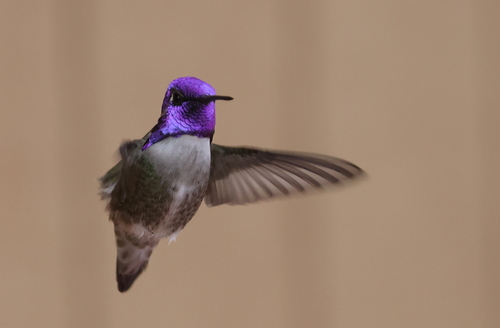
Costa's Hummingbird
Costa's Hummingbird (*Calypte costae*) is a small, vibrant hummingbird species primarily found in the arid regions of the southwestern United States and Mexico. Known for the male's striking iridescent purple crown and gorget (throat feathers), this species plays a crucial role in its ecosystem as a pollinator. It is well-adapted to desert life, often found in areas with sparse vegetation. Culturally, it is a symbol of resilience and adaptability, thriving in harsh environments where other species struggle.
7.6-8.9 cm
Length
10-11 cm
Wingspan
Least Concern
Conservation Status
Distribution
Southwestern United States (Southern California, Southern Nevada, Arizona, and southwestern Utah) and northwestern Mexico (Baja California Peninsula and Sonora). They are short-distance migrants, with some populations moving to higher elevations or coastal areas during the non-breeding season.
Lifespan
Average lifespan in the wild is not well-documented, but likely 3-5 years. Some individuals may live up to 8 years.
Costa's Hummingbird's Habitat
Habitat Types
Deserts, Chaparral, Coastal sage scrub, Arid woodlands
Climate Zones
Arid, Semi-arid, Mediterranean
Adaptations
Costa's Hummingbirds are adapted to hot, dry environments. They can enter a state of torpor, a short-term hibernation-like state, to conserve energy during cold nights or periods of food scarcity. They also have efficient kidneys to minimize water loss.
Variations
No recognized subspecies, although there may be slight variations in plumage intensity or size across the range.
Appearance
Breeding Plumage
Males have a brilliant iridescent purple crown and gorget during the breeding season. The gorget feathers extend down the sides of the neck. Females and immature birds lack the bright purple coloration and have a grayish-green back and whitish underparts.
Seasonal Feather Changes
Males may have slightly duller coloration outside of the breeding season.
Sex Based Plumage Differences
Significant sexual dimorphism, with males displaying the bright purple coloration while females are more cryptic.
Notable Features
Iridescent purple crown and gorget (males), Long, slender, slightly decurved bill, Small size
Diet and Feeding
Primary Foods
Nectar, Small insects, Spiders
Foraging Behavior
Costa's Hummingbirds primarily feed on nectar from flowers, using their long, extendable tongues. They also glean insects and spiders from foliage and catch them in mid-air.
Specializations
Their long, slender bill and specialized tongue are adapted for extracting nectar from tubular flowers. They are also agile fliers, able to hover and maneuver precisely while feeding.
Seasonal Diet Variations
Diet may shift slightly depending on the availability of nectar and insects. During periods of low nectar availability, they may consume more insects.
Behavior
Social Structure
Generally solitary, except during breeding season. Males are territorial and will defend feeding areas.
Communication
High-pitched chipping calls, Buzzing sounds produced by wings during flight, Visual displays (e.g., gorget flashing)
Migration
Some populations are resident, while others undertake short-distance migrations. Movements are often related to food availability and elevation changes.
Territorial or Group Behaviors
Males are highly territorial, especially during the breeding season. They will aggressively defend their feeding territories from other hummingbirds and even larger insects.
Conservation
Threats
Habitat loss and degradation (due to urbanization, agriculture, and wildfires), Pesticide use (which can reduce insect prey), Climate change (which can affect flowering times and nectar availability)
Protection Programs
Habitat restoration projects in some areas, Public education campaigns to promote hummingbird-friendly gardening practices
Local National Laws
Protected under the Migratory Bird Treaty Act in the United States.
Population Trend
Stable
Population Estimates
Global population estimated to be around 7,400,000.
Interesting Facts
They can enter torpor.
This allows them to conserve energy during cold nights or periods of food scarcity.
Males perform dramatic courtship dives.
These dives can reach speeds of up to 60 mph.
They are important pollinators.
They help pollinate many desert plants, contributing to the health of the ecosystem.
Their wings beat incredibly fast
The wings of Costa's Hummingbirds beat at about 50 beats per second.
Faqs about Costa's Hummingbird
What can I do to attract Costa's Hummingbirds to my yard?
Plant native flowering plants, especially those with red or orange tubular flowers. Provide a hummingbird feeder with a sugar-water solution (1 part sugar to 4 parts water), and avoid using pesticides.
How can I tell the difference between a male and female Costa's Hummingbird?
Males have a bright purple crown and gorget, while females have a grayish-green back and whitish underparts.
Do Costa's Hummingbirds migrate?
Some populations are resident, while others undertake short-distance migrations, often related to food availability.
Are Costa's Hummingbirds endangered?
No. Costa's Hummingbirds are classified as 'Least Concern' by the IUCN.
Copyright @ Nature Style Limited. All Rights Reserved.
 English
English